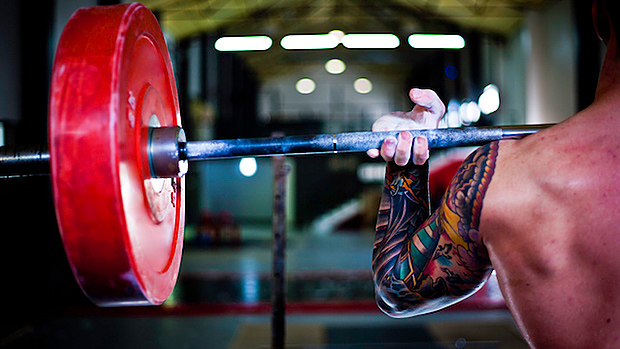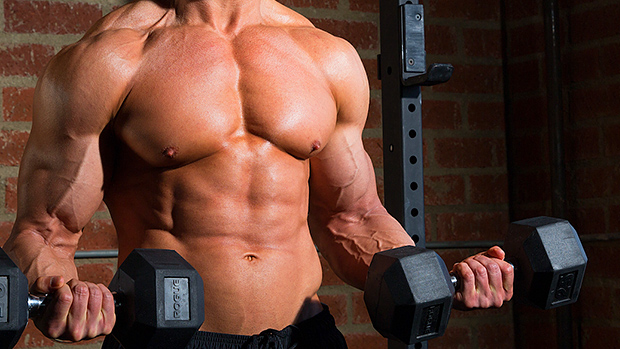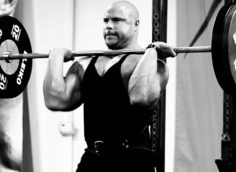Drop sets are a great way to increase work volume, which is why they've remained a staple for bodybuilders looking to extend their sets and get a killer pump. That said, drop sets usually involve extending the set by simply doing the very same exercise again, just with a lighter weight. There's nothing wrong with that, but there are other ways to do it.
Here are some new ways to add drop sets by using two different exercises that each train the same muscle group but at a different point within the range of motion. Why do that? To develop what I call "full range strength."
You'll need an adjustable cable column with a (preferably extra-long) rope. First, with the cable set above your head, perform triceps extensions using a weight that you can do for no more than 8-15 reps. Then, lower the cable to mid-torso height and do overhead extensions with your torso parallel to the floor, again for 8-15 reps.
When doing the regular extensions, the point of maximal mechanical tension (where you have the least mechanical advantage) is created in the mid to shortened position. With the overhead extensions, the point of maximal mechanical tension is created in the lengthened to mid-range position.
The point of max tension when doing cable extensions is when your forearm is at a 90-degree angle to the cable. To create a point of maximal tension when your triceps are in the stretched or lengthened position when your arms are overhead, you need the force vector (the cable) to pull almost parallel to your torso.
Since it's very awkward to get set up to do overhead extensions when the cable is set at ankle level, it makes more sense to create the same effect by setting the cable at roughly shoulder-height and simply leaning over and holding your torso parallel to the floor. So, the first exercise is the most difficult at the point within the range of motion, where the second exercise is the easiest on the lever-arm (moment arm) involved.
This same principle is also applied in all of the following drop sets. Not to mention, all of the drop set sequences are designed to have a nice flow to them while also being done in the same spot. This way, they can be done even during the busiest gym times.
You'll do both of the exercises unilaterally with a cable handle attached at ankle level.
Perform single-arm biceps curls using a weight you can do for 8-15 reps. Once you've done both arms, go back to the arm you started with and do face-away curls while using a weight you can do for no more than 8-15 reps.
The point of maximal mechanical tension when doing cable curls is when your forearm is at a 90-degree angle to the cable. This angle occurs closer to the mid to shortened range when facing the cable. However, when doing the face-away curls, it occurs more in the lengthened to mid-range.
First, do a set using a weight you can lift for 8-15 reps. Then perform a set of lying (supine) front raises using a weight you can do for 8-15 reps.
The point of maximal mechanical tension when doing front raises is when your arm is parallel to the floor. So when doing the seated raises, the point of max tension is when your arms are perpendicular to your torso. With the lying front raises, the point of max tension is when your arms are parallel to your torso.
You'll do both of these exercises unilaterally. First, do the dumbbell raises with your torso held at roughly a 45-degree angle while holding onto a cable machine with your other arm. Use a weight you can lift for around 8-15 reps. Once you've done both arms, go back to the arm you started with and do cable lateral raises with a handle that's set at knee height, again for 8-15 reps.
The point of maximal mechanical tension when doing the leaning lateral raise is at the top of the range of motion when your arm is parallel to the floor. It's the opposite when you set the handle at knee height. In that, the point of maximal tension is when your arm is at a 90-degree angle to the cable, which is when your arm is at the bottom of the range next to your torso.
With a handle set at shoulder-height, do a set of 8-15 reps while facing the cable column so the cable is centered on your torso. Once you've done both arms, go back to first arm and do a set with your torso perpendicular to the cable so the cable is just outside your side shoulder on your free arm.
The point of maximal mechanical tension is when your arm is at a 90-degree angle to the cable. So, when you're standing facing the cable, the point of maximal tension is created mostly when your arm is out to the side (in the mid to shortened range). When you're standing perpendicular to the cable, the point of max tension is created more when your arm is across and in front of your body (lengthened to mid-range).
You'll also do both of the exercises unilaterally with a cable handle attached at shoulder level.
First, do a set with your torso perpendicular to the cable so the cable is just outside the shoulder of your working arm. Do 8-15 reps. Once you've done both arms, go back to the arm you started with and do a set while facing away from the column so the cable is directly behind your hand when your arm is out to the side.
The point of max mechanical tension is when your arm is at a 90-degree angle to the cable. So when doing the exercise with your torso perpendicular to the cable, the movement of horizontal shoulder adduction is challenged far more when your arm is in front of and across your torso (in the mid to shortened range).
On the flipside, facing away from the cable column challenges this same movement far more when your arm is out to the side (in the lengthened to mid-range).
Using a rope or bar handle attached to a cable that's set above your head, do a set with an upright torso while standing about 4-5 feet back from the cable column (8-15 reps). Then do a set with your torso parallel to the floor.
The point of maximal mechanical tension is when your arms form a 90-degree angle to the cable. So, upright torso pulldowns focus more on training you in the shortened to mid-range aspects of shoulder extension. Performing them with your torso parallel to the floor focuses more on the lengthened to mid-range.
- On all cable exercises, you can manipulate the point of maximal mechanical tension within a given range of motion by changing the angle of the cable. For example, if you stand far back from the cable while doing triceps extensions with an upright torso you'll create a different point of max tension than if you were standing closer to the cable (the angle of the cable will be different).
- To keep things simple, I used two categories of exercises above: shortened to mid-range, and lengthened to mid-range. You can take this a step further by classifying exercises into three categories: shortened range, mid-range, and lengthened range. And you can do triple drop sets if you really like using the drop-set concept and gravitate towards more high volume training.
- The 8-15 rep range is just a general recommendation, not a rule.
- Adjust the weight accordingly for each exercise within a given drop set to accomplish the recommend rep range using good control and technique.
- Generally, do 2 to 3 sets of a given drop set.
- You can do any of the exercises in reverse order if you prefer, or just to mix it up.
- These drop sets are a great method to use when you're short on time.





